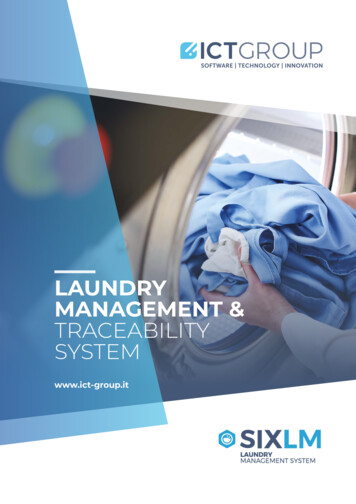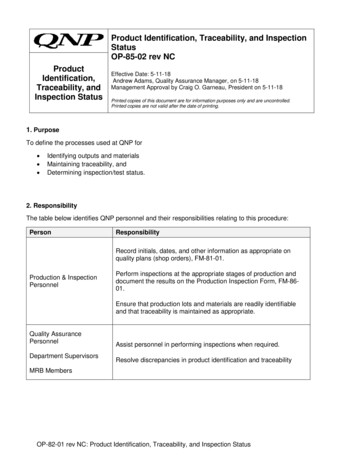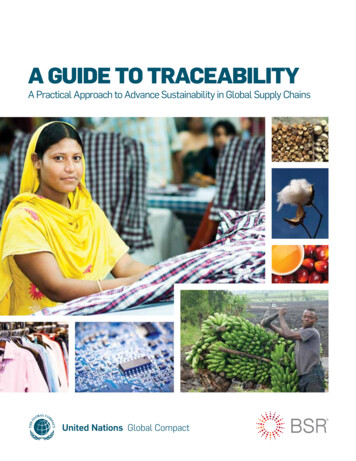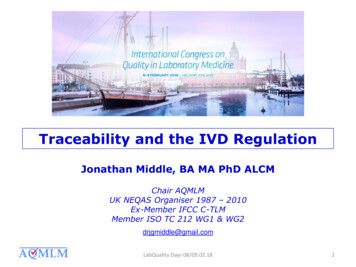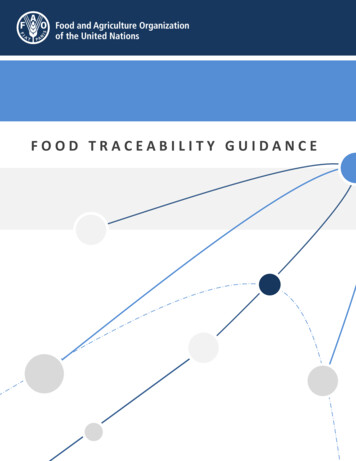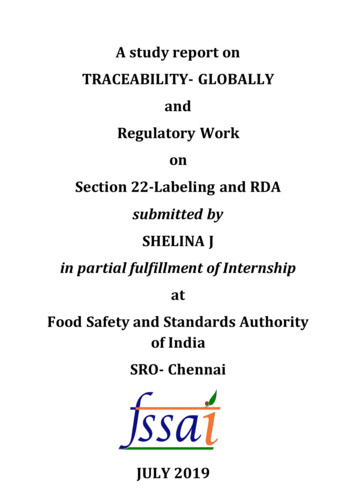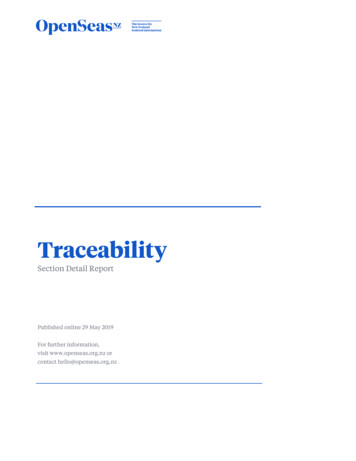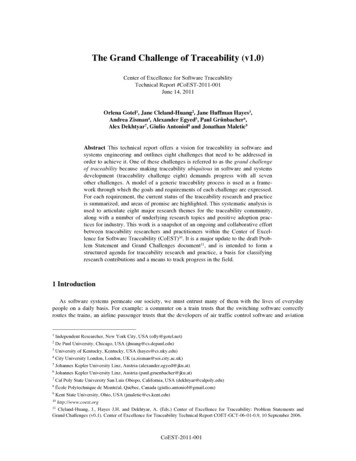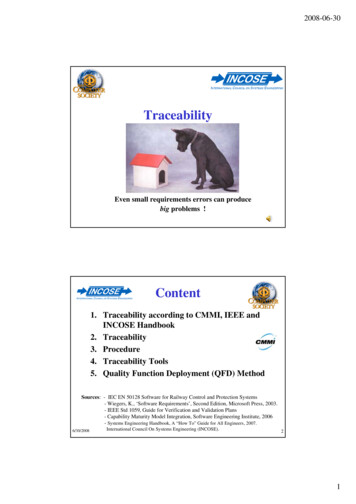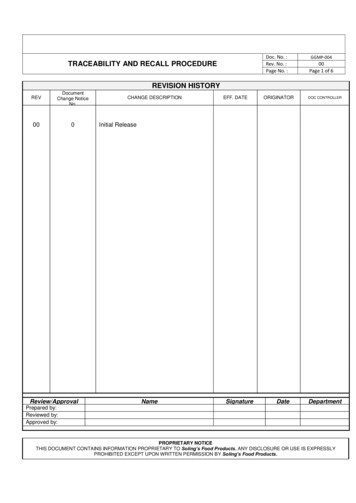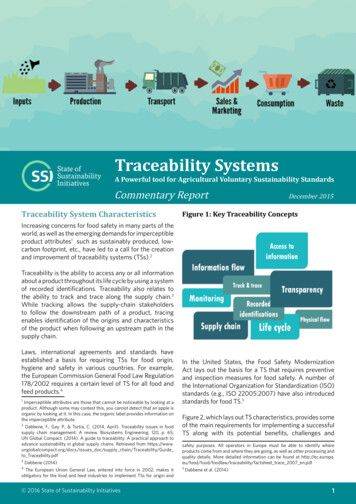
Transcription
Traceability SystemsA Powerful tool for Agricultural Voluntary Sustainability StandardsCommentary ReportTraceability System CharacteristicsDecember 2015Figure 1: Key Traceability ConceptsIncreasing concerns for food safety in many parts of theworld, as well as the emerging demands for imperceptibleproduct attributes1 such as sustainably produced, lowcarbon footprint, etc., have led to a call for the creationand improvement of traceability systems (TSs).2Traceability is the ability to access any or all informationabout a product throughout its life cycle by using a systemof recorded identifications. Traceability also relates tothe ability to track and trace along the supply chain.3While tracking allows the supply-chain stakeholdersto follow the downstream path of a product, tracingenables identification of the origins and characteristicsof the product when following an upstream path in thesupply chain.Laws, international agreements and standards haveestablished a basis for requiring TSs for food origin,hygiene and safety in various countries. For example,the European Commission General Food Law Regulation178/2002 requires a certain level of TS for all food andfeed products.41Imperceptible attributes are those that cannot be noticeable by looking at aproduct. Although some may contest this, you cannot detect that an apple isorganic by looking at it. In this case, the organic label provides information onthe imperceptible attribute.2Dabbene, F., Gay, P., & Tortia, C. (2014, April). Traceability issues in foodsupply chain management: A review. Biosystems Engineering, 120, p. 65;UN Global Compact. (2014). A guide to traceability: A practical approach toadvance sustainability in global supply chains. Retrieved from https://www.unglobalcompact.org/docs/issues doc/supply chain/Traceability/Guideto Traceability.pdf3Dabbene (2014)4The European Union General Law, entered into force in 2002, makes itobligatory for the food and feed industries to implement TSs for origin and 2016 State of Sustainability InitiativesIn the United States, the Food Safety ModernizationAct lays out the basis for a TS that requires preventiveand inspection measures for food safety. A number ofthe International Organization for Standardization (ISO)standards (e.g., ISO 22005:2007) have also introducedstandards for food TS.5Figure 2, which lays out TS characteristics, provides someof the main requirements for implementing a successfulTS along with its potential benefits, challenges andsafety purposes. All operators in Europe must be able to identify whereproducts come from and where they are going, as well as other processing andquality details. More detailed information can be found at /factsheet trace 2007 en.pdf5Dabbene et al. (2014)1
Commentary ReportFigure 2: Traceability Systems Characteristicsopportunities.6Did you know?A Tool to Ensure Reliability ofSustainability ClaimsFull TSs are being developed or have been adopted fora number of VSSs. Developing a TS requires significanteffort, allowing stakeholders along supply chains toshare information to track and trace the transformationand value addition of commodities allowing crediblesustainability claims at various stages of the supplychain. The key to an effective TS is the willingness ofsupply chain stakeholders to adequately collect andshare important data resulting in value addition for allsupply chain stakeholders.Traceability can assist with determining the reliabilityof certain claims associated with a product’s attributes,which can strengthen transparency along the supplychain. This is the case for sustainability claims madeby voluntary sustainability standards (VSS). The UnitedNations Global Compact’s guide for traceability maintainsthat TSs ensure “the reliability of sustainability claims, inthe areas of human rights, labour (including health andsafety), the environment and anti-corruption.”7Ongoing Discussions on Sustainabilityin Supply ChainsRecent discussions on sustainability in supply chainsdescribe TS as an important tool for VSS to improve the6The Traceability System Characteristics chart was compiled based onanalyzing information found in the following sources: Dabbene, et al. (2014);UN Global Compact (2014); Lindh, H., & Olsson, A. (2010). Communicatingimperceptible product attributes through traceability: A case study in anorganic food supply chain; Renewable Agriculture & Food Systems, 25(4), 263;Olsen, P. & Borit, M. (2013), How to define traceability. Trends in Food Science& Technology, 29(2), 142–150. http://doi.org/10.1016/j.tifs.2012.10.003;Storøy, J., Thakur, M., & Olsen, P. (2013). The TraceFood Framework: Principlesand guidelines for implementing traceability in food value chains. Journal ofFood Engineering, 115(1), 41–48. Retrieved from http://doi.org/10.1016/j.jfoodeng.2012.09.0187UN Global Compact (2014, p. 6) 2016 State of Sustainability Initiativesvalidity of sustainability claims. Furthermore, there isa growing need for rigorous VSS impact information toshow evidence of sustainability claims and communicatehow VSSs contribute to meeting sustainabledevelopment goals (SDGs).8 During the ISEAL Alliance2014 Global Sustainability Standards Conference,representatives of two key purchasers in agriculturalsupply chains, Unilever and Mondelez International,highlighted the need for companies to show evidencethat their sustainably sourced materials are drivingchange toward sustainability in order to build trust in8Davis de Andrade Lessa, J. (2014). Goal systems: An exploration oflinks between voluntary sustainability standards in agriculture and publicsustainable development goals. CEU Department of Environmental Sciences& Policy Master Theses 2014/6. Budapest: CEU, Budapest College; Potts, P.,van der Meer, J., & Daitchman, J. (2010). The state of sustainability initiativesreview 2010: Sustainability and transparency. Retrieved from http://www.iisd.org/pdf/2010/ssi sustainability review 2010.pdf2
Commentary Reporttheir sustainability claims.9 During the InternationalTrade Centre’s (ITC) Trade for Sustainable DevelopmentForum 2014, a panel discussion featuring a cross sectionof private sector purchasers maintained that effectivecommunication, data sharing and supplier-suppliercollaboration are fundamental for supply chains.10 TheUnited Nations Global Compact suggests that there areincreasing demands for more detailed information oncharacteristics and impacts of VSS.11 TS can potentiallyassist with fulfilling this need.By providing access to information on the components,parts and materials of products, as well as informationon transformations throughout the value chain, TSscan aid in the delivery of transparency and evidence forsustainability claims. Increased transparency also leadsto improving and facilitating participatory governance,which is imperative for sustainable development.12 Byfacilitating transparency, VSSs also enable the marketto communicate and promote efficiency, social welfareand cost-internalization, which are fundamental tosustainable development. Transparency also providesinvestors, policy-makers and donors with the necessaryunderstanding of sustainability in supply chains, enablingmeaningful decisions for accountability.13Steps Towards More TraceabilityRecent developments within some VSSs demonstrateserious efforts in implementing more traceabilitywithin supply chains, which can be challenging tovarying degrees, depending on the commodity sector.For instance, VSS chain-of-custody specificationsare regularly revisited to strengthen traceability andtransparency along the supply chain. The Roundtablefor Sustainable Biomaterials recently revised their chainof custody standard to enhance clarity, ease of use andcompleteness.14The 2014 Roundtable for Sustainable Palm Oil (RSPO)annual general meeting concluded with a vote on animportant resolution tabled by Unilever to enhancetraceability. The resolution, which narrowly passed (96for, 84 against, 37 abstained), moved the RSPO memberscloser to implementing full traceability and greatertransparency in their supply chains by imposing thedisclosure of specific mills linked to book and claim, mass9Davis de Andrade Lessa, J. (2014).International Trade Centre News (2014, October 3). Buyers see transparencyand traceability as the challenges for sustainability standards. Retrieved inability-standards11UN Global Compact (2014)12Ibid.13Potts et al. (2010)14Roundtable for Sustainable Biomaterials (2014). RSB Standard forTraceability of RSB Certified Material (Chain of Custody) Version 3.1.Retrieved from 3.1%20RSB%20Std%20for%20Traceability.pdf10 2016 State of Sustainability Initiativesbalance or segregated RSPO certified palm oil and palmkernel oil purchases. It was argued that implementingmore traceability in the supply chain would enableRSPO member companies to achieve zero deforestation.Knowing exactly how palm oil flows through the supplychain, including which mills and plants process the palmfruit and kernel, will move RSPO towards full traceability.Unilever, the proponent of the resolution, maintainedthat current transactions do not require the disclosureof certified mills. Book and claim must have informationon the source of certified mills on green palm certificatesand etrace mass balance, and segregated palm oil shoulddisclose certified mills. Unilever “would like to mandatethe RSPO to work with book and claim and the etracesystem so that any buyer of RSPO certified palm oil hasfull traceability including the mills.”15Some members argued against the resolution by statingthat traceability is more important for conventionalproduction. Tracing back to the mills for book andclaim as well as mass balance will be challenging, andmill disclosure may be disadvantageous to some RSPOmembers. Other members argued for the resolution bypointing out the virtues of traceability to source palm oilfrom mills with a lower carbon footprint and increasingthe competitiveness of RSPO members.The challenge associated with implementing theresolution was also highlighted by pointing out thedifficulties with tracking the crusher plants involved inextracting palm kernel oil and in tracing mills for massbalance where mixed certified and uncertified palm oilproduct are sold.The following question posed to Unilever highlightedsome of the reservations around the resolution: “Areyour intentions to support specific mills in your supplybase?”16The Unilever representative answered that, in their 900mill supply base, only 10 per cent are certified, and that,although complete traceability is challenging, it will helpmove the overall sector towards sustainability.RSPO members were left with mixed feelings on theapproved resolution, with some feeling that it representedan important step towards full traceability and thereforetransparency for sustainability, and others feeling thatimplementing the resolution for both palm oil and palmoil kernel would be a challenge. Overall, this importantdevelopment towards traceability demonstrates RSPO’s15Unilever Representative, Proposed Resolution at the 11th General Assemblyof the Roundtable on Sustainable Palm Oil - Resolution 6f: Declaration of Mills(Kuala Lampur, 2014).16Roundtable on Sustainable Palm Oil Member, Proposed Resolution at the11th General Assembly of the Roundtable on Sustainable Palm Oil - Resolution6f: Declaration of Mills (Kuala Lampur, 2014).3
Commentary Reportcommitment to transparency and its push for furthersustainability within the palm oil and palm kernel oilcommodity sectors.Sustainability via Traceability SystemsTSs provide a foundation for improving transparencyalong supply chains, facilitating the development ofmonitoring systems, allowing access to information,enabling agricultural goods to be traceable and improvingthe reliability of sustainability claims. By enablingtransparency, TS can build bridges between producers,governments, non- governmental organizations andmarket actors, providing a basis for ensuring that VSSscontribute to achieving the SDGs.Traceability systems can be integrated within data-sharingplatforms along supply chains, providing an opportunityto add additional value to traceability efforts. Welldesigned data-sharing platforms provide an opportunityto fast-track sustainability within commodity sectorsby aggregating information among its data providers ina supply chain to provide important intelligence for thesector as a whole while maintaining the confidentiality ofsensitive information. Supplyshift provides one exampleof such data-sharing platforms providing flexibilityfor information sharing through aggregation whilemaintaining information confidentiality. In doing so, itsdata-sharing participants receive additional competitiveand sustainability intelligence.1717For more information on supplyshift, see https://www.supplyshift.net 2016 State of Sustainability Initiatives4
Author: Jefferson Andrade & Vivek VooraPhoto credits: Aynur Mammadova via piktochart.comDesign: Aynur MammadovaThe SSI Commentaries are drafted in the form of short briefs to contribute to ongoing reflections on how voluntary sustainability standards can best address a range of sustainable consumption and production issues.The SSI is a collaborative effort funded by the State Secretariat forEconomic Affairs (SECO) and led by the International Institute forSustainable Development (IISD), the International Institute for Environment and Development (IIED) and the Finance Alliance for Sustainable Trade (FAST).www.iisd.org/ssiemail: infossianalytics.orgTwitter: SSI News 2016 State of Sustainability Initiatives 2016 State of Sustainability Initiatives5
Traceability Systems A Powerful tool for Agricultural Voluntary Sustainability Standards Traceability System Characteristics Increasing concerns for food safety in many parts of the world, as well as the emerging demands for imperceptible product attributes1 such as sustainably produced, low-carbon footprint, etc., have led to a call for the creation and improvement of traceability systems .
